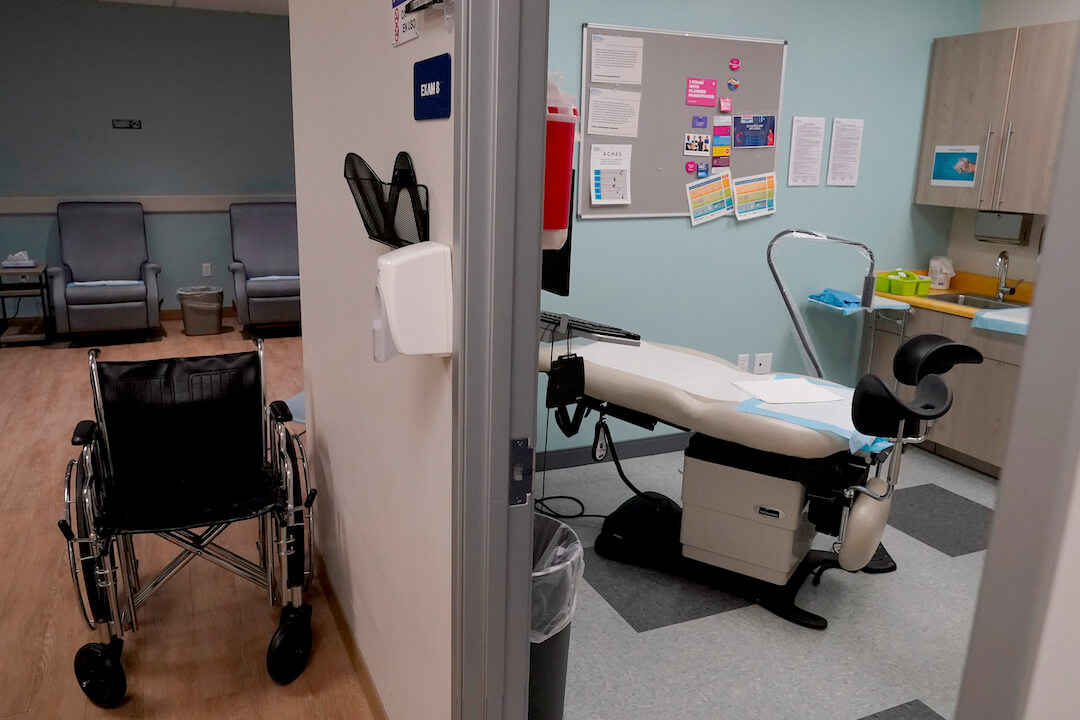Abortion may be one of the most divisive issues in American discourse, but polls show most Americans agree on one thing: Doctors should be free to perform emergency abortions when a pregnant woman’s life is in danger.
Eighty-two percent of people polled in April said they support abortion when it is deemed necessary to “protect the life and health of the pregnant person.” But as 25 states have banned abortion or tightened restrictions in the year since the Supreme Court issued its landmark ruling overturning Roe v. Wade, attempts to codify these exceptions have left doctors and their patients in a complicated limbo.
Dr. Jack Resneck Jr., former American Medical Association president, described the predicament as leaving the medical community “caught between good medicine and bad law.”
Though all states with abortion restrictions include exceptions for the mother’s life, attempts to implement them show they can be ineffective in practice. Doctors say they wrestle with vague laws; it’s often hard to determine whether a patient’s case qualifies as an exception.
In complicated cases, physicians find themselves weighing patients’ medical conditions against concerns about their own legal liability. The penalties for mistakes are severe: In some states, violating abortion laws is considered a felony, and can be punishable by large fines and between a decade to life in prison.
Bob Ramsey, a Republican former Tennessee state representative, told The New York Times in January that confusion is intentional.
“The more confusing it is, the more likely there will be no abortion in the state of Tennessee,” he said. “That’s a win for people who are opposed to abortion.”
Legal experts said that just because an abortion exception is included in a law doesn’t mean it will lead to any access.
“The fact that an exception exists doesn’t necessarily mean that it works,” said Mary Ziegler, an abortion historian and law professor at University of California, Davis.
To address ambiguity in the exceptions to his state’s abortion ban, Texas Gov. Greg Abbott in June signed a law to clarify that the six-week ban doesn’t apply in cases of ectopic pregnancies. Ectopic pregnancies happen when a fertilized egg implants outside the uterus, often in the fallopian tube. These pregnancies aren’t viable, and if left untreated can lead to life-threatening bleeding.
Treatment of an ectopic pregnancy is not the exact same medical procedure as an abortion, but it requires removing the pregnancy via surgery or medication. State Sen. Bryan Hughes, R-Mineola, the bill’s sponsor, told the conservative National Review that medical providers were delaying or withholding care, concerned about violating the state’s abortion laws.
Health exception language is problematic, legal experts and doctors say
Medical associations and reproductive law experts told PolitiFact that when providers hesitate to provide care to pregnant mothers experiencing life-threatening conditions, it’s often because of vague, narrow and nonclinical wording of states’ health and life exceptions.
Under Ohio’s six-week abortion ban, for example, the health exception lists a couple of conditions that would apply, such as preeclampsia and premature rupture of the membranes, but offers no further detail. In a lawsuit challenging the state’s ban, providers said the ambiguity makes it impossible to treat patients with other significant health problems. It cited the example of a pregnant woman with stage 3 melanoma who was denied both abortion care and cancer treatment because clinicians couldn’t confirm whether the law’s life of the mother exception applied.
Georgia’s health exception says an abortion can be performed “to prevent the death of the pregnant woman or the substantial and irreversible physical impairment of a major bodily function.”
Providers challenging the ban argue that this language doesn’t permit abortion care when the condition is “substantial but reversible,” “less than substantial but irreversible,” or both “substantial and irreversible” but not considered “major.” Their lawsuit questions how doctors are expected to navigate this type of confusion.
“What does the risk of death have to be, and how imminent must it be?” asked Lisa Harris, a University of Michigan professor of reproductive health, who wrote in The New England Journal of Medicine shortly before Roe v. Wade was overturned. “Might abortion be permissible in a patient with pulmonary hypertension, for whom we cite a 30-to-50% chance of dying with ongoing pregnancy? Or must it be 100%?”
A Kaiser Family Foundation review found that several states have contradictory language within their own laws, only adding to the confusion.
When asked whether any states had well-written health exceptions, legal experts had no examples and added that many of the states’ laws restricting abortion mirror one another.
The legal implications
Here’s another pressure on doctors: Some states, such as Idaho, are embedding in their abortion laws an “affirmative defense” approach, which means doctors must prove a lack of wrongdoing when performing an abortion out of medical necessity.
“Instead of the prosecutor trying to prove you weren’t saving a life — the typical innocent until proven guilty — the defendant now has to prove that they were saving a life,” Ziegler said. “There is now a presumption of guilt. It’s much harder to prove and that’s putting an additional thumb on the scale in a way that’s going to frighten doctors.”
Should the courts disagree with a doctor’s defense, the penalties for performing an unsanctioned abortion are severe:
“In some states it’s up to life in prison. In others it’s five years in prison and substantial fines and loss of a medical license,” Ziegler said. “At a minimum, it’s going to be the end of somebody’s career.”
Dr. Karen Harris, a practicing OB-GYN and member of Florida’s Maternal Mortality Review Committee, called the penalties “a very scary prospect.”
“They can take away our license because they thought we didn’t follow the law and we thought we did,” Harris said. “Who is going to determine that? A judge who is not medically trained? A jury?”
PolitiFact could find no recent examples of doctors being prosecuted for performing medically necessary abortions under these laws. One physician in Indiana faced fines for breaching patient confidentiality after talking about her patient’s experience. Some state prosecutors are also refusing to enforce abortion laws, worsening confusion as doctors consider their personal liability.
These laws have primarily had a chilling effect, legal experts told us.
“There hasn’t been any case law or an example of a case that has been brought through the courts that demonstrated a successful physician defense,” Harris said. “No one wants to be that first person because they’re threatening medical licenses.”
Hospitals scramble to create new protocols to comply
An April 2023 case study in Oklahoma showed that hospitals were no more clear than doctors on how to interpret state abortion bans. In the study, research assistants posed as prospective patients and called hospitals to ask questions about emergency pregnancy care. The study found that 65% of hospitals contacted “were unable to provide information about procedures, policies, or support provided to doctors when the clinical decision is that it is necessary to terminate a pregnancy to save the life of a pregnant patient.”
Almost none of the hospitals provided physicians with legal support.
Some hospitals recommend having lawyers on call to help doctors determine whether a woman’s condition is severe enough to justify abortion care. Others have instituted policies that require additional physicians review the cases before abortions can proceed.
“Every hospital is creating their own rules,” Harris said.
That leaves pregnant women in limbo. A recent review of two Dallas hospitals found pregnant patients who were seeking abortions waited an average of nine days while doctors and lawyers assessed whether their medical conditions were life threatening enough to qualify. Some patients suffered serious complications while they waited, including hemorrhage and sepsis.
A May 2023 report on patient care post-Roe by ANSIRH, an abortion and reproductive health research program at UC-San Francisco, found that the laws and their interpretations “contributed to delays, worsened health outcomes, and increased the cost and logistic complexity of care.” In several cases, patients experienced preventable and severe complications because clinicians reported that their ‘hands were tied,’ making it impossible for them to provide treatment sooner.”
Doctors and hospitals, meanwhile, are under a countervailing pressure: The Emergency Medical Treatment and Labor Act requires that emergency rooms provide stabilizing treatment to patients in emergency situations, or transfer them to a hospital that can.
In a July 2022 letter to medical providers, the Biden administration said that under the law, even in states that ban abortion, physicians “must provide” the procedure if it is required to stabilize a woman’s health.
A federal investigation later found that two hospitals in Kansas and Missouri broke the law when they refused to provide an abortion to a woman experiencing a medical emergency — premature labor at 18 weeks pregnancy. In a statement about the investigation’s findings, Health and Human Services Secretary Xavier Becerra reiterated that protections for patients seeking emergency care include abortion.
North Carolina OB-GYN Dr. Jonas Swartz said he and his colleagues are preparing for the state’s new abortion law to take effect July 1. It has a narrowly worded exception for a “medical emergency” allowing a woman to receive an abortion only when it is needed “to avert her death or for which a delay (to abortion care) will create serious risk of substantial and irreversible physical impairment of a major bodily function.”
“I want to be in compliance with the law,” Swartz said. “My colleagues want to be in compliance with the law. And I know that my hospital system is working for all of us to be in compliance with the law.”
But he said he’s thinking ahead to exactly what medical emergencies will qualify — at least those he can predict.
“You have to think prospectively about what some medical emergencies you know are going to surface,” he said, “and then realize that there’s no cookbook.”
PolitiFact researcher Caryn Baird contributed to this report.
This fact check was originally published by PolitiFact, which is part of the Poynter Institute. See the sources for this fact check here.








